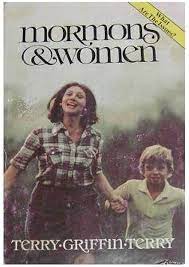Articles/Essays – Volume 15, No. 2
Nothing New Under the Sun | Ann Terry, Marilyn Slaght-Griffin, and Elizabeth Terry, Mormons & Women
I admit an acquired skepticism about books with pretentious titles, so my eyes narrowed at the sight of a slim volume with the weighty title Mor mons & Women. I became even more suspicious when I read the authors’ stated purpose . . . “to trace the wo men’s movement from its beginnings to the current issues surrounding the ratification of the Equal Rights Amendment, with an in-depth discussion of the modern Latter-day Saint woman .. . to detail the position of the Mormon leaders regarding the Equal Rights Amendment fairly, as well as shed light on their misrepresented lobbying activities. The true works of the Lord and his people will never be cloaked in secrecy. Let the truth be known.” And all that in 150 pages . . . whew!
Unfortunately, ambition exceeded ability in Mormons & Women, and the book falls far short of the promise of its tantalizing title.
The three authors, a mother and daughter team and a nonmember (the one with the hyphenated name) seem to have divided up the writing of the book—thus the resulting unevenness in quality and tone and hodge-podge construction.
The first twenty-five pages of the book are a discussion of doctrinal and social roles for women in Mormon life, touching on problems with stereotyping the “down-trodden” Mormon mother, briefly discussing the difficulties of mothers of small children, discrimination at BYU and elsewhere, quoting, at one point, BYU professor Dr. Brent Barlow, that “Mormons are beginning to divest themselves of ‘Archie Bunker type notions’ about the role of women which are not justified by LDS doctrine about the patriarchial role of the family.”
The authors of this section (presumably the Terrys) make clear their understanding of church directives as requiring mothers to stay home as primary caretaker, leaving to work only out of economic necessity and then, citing Alison Craig’s Ensign article, preferring working from one’s home. The Terrys decribe man as “by nature more aggressive and bold . . . best suited to confront the world . . . His physical part in nurturing offspring is small when compared to the female.”
A well-written though brief section on the history of American feminism follows. The Terrys discuss the dangers of the ERA and reasons for church opposition to it. After reciting a statement by the First Presidency carried in the Ensign, the authors fall back on what must sound best to them: the words of Senators Orrin Hatch and Sam Ervin, and Phyllis Schlafly (through her organization, STOP ERA and its publication, Eagle Forum Newsletter).
This is the greatest disappointment of the book, for the authors defend and explain the Church’s stand on ERA with Phyllis Schlafly’s political argument. Where does that leave the member who finds these arguments unacceptable? On the outside, ac cording to chapter 10 of the book, entitled “Can a Good Mormon be a Pro ERA?” While the authors acknowledge church spokesman Don LeFevre’s official statement that “support for ERA is not ground for court action,” they nevertheless con clude that supporters are not good Mormons. The Terrys use, as an example, Susan Howard, who, dur ing the height of the Sonia crisis, wrote a letter in defense of the Church to the LA Times, which read, in part:
The answer to the question, posed by columnist Ellen Goodman, “Can a Mormon be a Feminist?” is a definite yes . . . Speaking for myself as a fifth generation Mormon and a feminist supporter of the ERA, I believe that the Church and the women’s movement have much to learn from each other.”
To Howard, the Terrys say:
It is difficult to reconcile the fact that her views, as an ERA proponent, are in direct conflict with those of President Kimball.
The Terrys describe Howard with words used by a Catholic priest in explaining his ability to live with a church which he does not entirely believe, saying that she evidently feels she is “loyal to the church, enjoys being a part of it, without necessarily taking seriously everything the Church leadership says.”
The authors describe free agency as a process whereby each faithful member has had to search and study, fast and pray until he or she could say that the beliefs and doctrines of the Church are true and that it is led by a prophet, whose direction the members follow. Once having received that witness, having gained that faith, one does not need to struggle daily with each social issue that erupts.
The book offers no alternative for those who, try as they might, have been unable to gain a testimony of Phyllis Schlafly; and certainly it contains no new insights or information for the many members who are trying to come to terms with the issue.
Mormons & Women, by Ann Terry, Marilyn Slaght-Griffin and Elizabeth Terry, Santa Barbara, California: Butterfly Publishing Inc., 1980, 150 pp. $1.95.


 Back to full Issue
Back to full Issue

